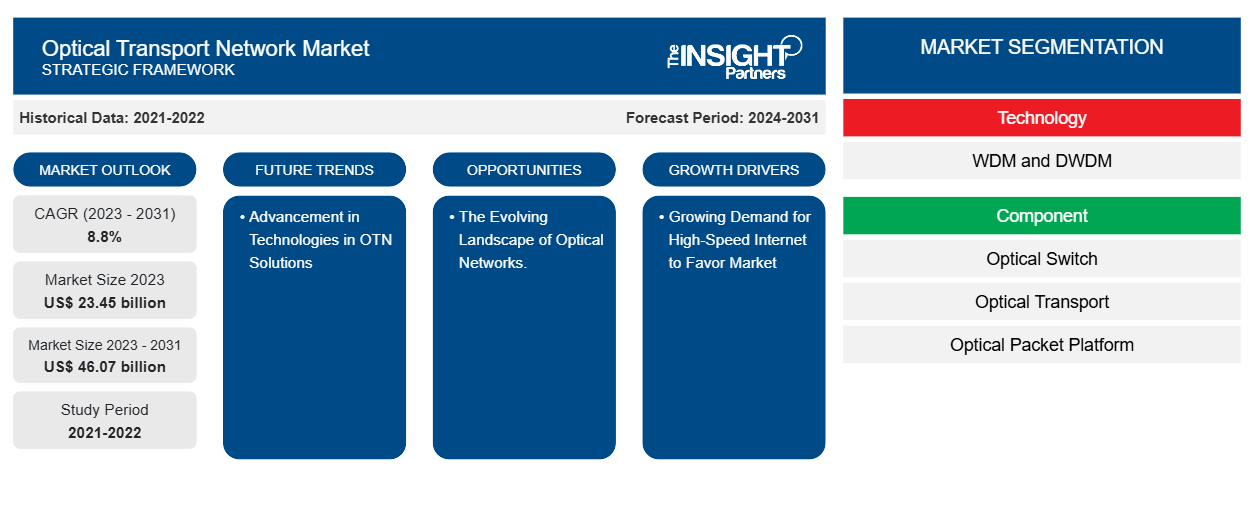The Optical Transport Network market size is projected to reach US$ 46.07 billion by 2031 from US$ 23.45 billion in 2023. The market is expected to register a CAGR of 8.8% in 2023—2031. Increasing demand for greater bandwidth with improved internet networks and advancements in technology made by OTN solution providers is likely to remain a key optical transport network market trend.
Optical Transport Network Market Analysis
There is currently a greater need for network capacity due to the sharp rise in both residential and office internet users. The demand for the market under study is anticipated to be driven by the rising popularity of social networking, video conferencing, online games, and other real-time streaming activities. The fact that optical transport networks minimize latency and provide seamless data transfer is one of the main factors driving the market's growth.
Optical Transport Network Market Overview
Using optical fiber to transfer data between nodes, optical transport networks (OTNs) are tiered, hierarchical networks. Digital wrappers such as the next-generation industry standard OTN provide a convenient and fast way to multiplex different services onto optical light pathways. It is an assembly of optical network elements connected by optical fiber that is capable of transporting, multiplexing, switching, controlling, monitoring, and maintaining the operation of optical channels that convey client signals.
Customize This Report To Suit Your Requirement
You will get customization on any report - free of charge - including parts of this report, or country-level analysis, Excel Data pack, as well as avail great offers and discounts for start-ups & universities
Optical Transport Network Market: Strategic Insights

-
Get Top Key Market Trends of this report.This FREE sample will include data analysis, ranging from market trends to estimates and forecasts.
Optical Transport Network Market Drivers and Opportunities
Growing Demand for High-Speed Internet to Favor Market
The need for internet penetration is also influenced by the degree of urbanization. Because of these advancements, more individuals are using the internet, which is beneficial for the market's growth. In addition, the concept of smart cities is driving the demand for high-speed internet. One essential element of the infrastructure of smart cities is the Internet of Things, which links numerous devices in the public, commercial, and personal domains—from mobile phones to wearables.
The Evolving Landscape of Optical Networks.
The optical network environment is changing swiftly, and in the upcoming years, it is expected to expand considerably. The pandemic has brought to light the importance of virtual networks for entertainment as well as remote study and work from home, notwithstanding the challenges associated with managing optical transport. All of the network's categories are expected to increase significantly over the next few years. The edge of the network is connected to residential broadband and the metro is not far behind the data center connection.
Optical Transport Network Market Report Segmentation Analysis
Key segments that contributed to the derivation of the optical transport network market analysis are technology, component, service, and end-use.
- Based on technology, the optical transport network market is divided into WDM and DWDM. The WDM segment is anticipated to grow in the forecast period.
- By component, the market is segmented into optical switches, optical transport, and optical packet platforms. The optical switches segment is anticipated to grow in the forecast period.
- Based on service, the optical transport network market is divided into network design and network maintenance and support. The network design segment is anticipated to grow in the forecast period.
- In terms of end-users, the market is bifurcated into communication service providers, enterprises, and government. The communication service providers segment is anticipated to grow at a significant rate over the forecast period.
Optical Transport Network Market Share Analysis by Geography
The geographic scope of the optical transport network market report is mainly divided into five regions: North America, Asia Pacific, Europe, Middle East & Africa, and South America/South & Central America. North America has dominated the optical transport network market. High technology adoption trends in various industries in the North American region have fuelled the growth of the optical transport network market. Factors such as increased adoption of digital tools and high technological spending by government agencies are expected to drive the North American optical transport network market growth. Moreover, a strong emphasis on research and development in the developed economies of the US and Canada is forcing the North American players to bring technologically advanced solutions into the market. In addition, the US has a large number of optical transport network market players who have been increasingly focusing on developing innovative solutions. All these factors contribute to the region's growth of the optical transport network market.
OPTICAL TRANSPORT NETWORK
Optical Transport Network Market Regional InsightsThe regional trends and factors influencing the Optical Transport Network Market throughout the forecast period have been thoroughly explained by the analysts at The Insight Partners. This section also discusses Optical Transport Network Market segments and geography across North America, Europe, Asia Pacific, Middle East and Africa, and South and Central America.
Optical Transport Network Market Report Scope
| Report Attribute | Details |
|---|---|
| Market size in 2023 | US$ 23.45 billion |
| Market Size by 2031 | US$ 46.07 billion |
| Global CAGR (2023 - 2031) | 8.8% |
| Historical Data | 2021-2022 |
| Forecast period | 2024-2031 |
| Segments Covered |
By Technology
|
| Regions and Countries Covered |
North America
|
| Market leaders and key company profiles |
|
Optical Transport Network Market Players Density: Understanding Its Impact on Business Dynamics
The Optical Transport Network Market is growing rapidly, driven by increasing end-user demand due to factors such as evolving consumer preferences, technological advancements, and greater awareness of the product's benefits. As demand rises, businesses are expanding their offerings, innovating to meet consumer needs, and capitalizing on emerging trends, which further fuels market growth.

- Get the Optical Transport Network Market top key players overview
Optical Transport Network Market News and Recent Developments
The optical transport network market is evaluated by gathering qualitative and quantitative data post primary and secondary research, which includes important corporate publications, association data, and databases. The following is a list of developments in the market:
- In March 2024, - Transworld Associates (TWA) will use Nokia’s optical transport solution to build a new optical network connecting Pakistan, the United Arab Emirates (UAE), and Oman as part of its submarine capacity expansion plan. A submarine capacity backhaul system is also being deployed in Karachi Metro. The project will support transformation in the region by accommodating the exponential growth of data and bandwidth links between data centers.
(Source: Nokia, Press Release, 2024)
- In November 2023, Nokia partnered with Bharti Airtel in order to deploy an optical transport network to meet the increasing demands of India's SG landscape. The collaboration will provide Airtel with enhanced capacity and reliability, resulting in improved services for its customers. Airtel will leverage Nokia's OTN switches to upgrade its transport switching infrastructure and increase overall capacity and bandwidth efficiency.
(Source: Aptean, Press Release, 2022)
OPTICAL TRANSPORT NETWORK Market Report Coverage and Deliverables
The "Optical Transport Network Market Size and Forecast (2021–2031)" report provides a detailed analysis of the market covering below areas:
- Market size and forecast at global, regional, and country levels for all the key market segments covered under the scope
- Market dynamics such as drivers, restraints, and key opportunities
- Key future trends
- Detailed PEST/Porter's Five Forces and SWOT analysis
- Global and regional market analysis covering key market trends, major players, regulations, and recent market developments
- Industry landscape and competition analysis covering market concentration, heat map analysis, prominent players, and recent developments
- Detailed company profiles
Frequently Asked Questions
What is the estimated market size for the global optical transport network market in 2023?
What are the driving factors impacting the global optical transport network market?
What are the opportunities of the global optical transport network market?
Which are the key players holding the major market share of the optical transport network market?
What will be the market size for the global optical transport network market by 2031?
- Historical Analysis (2 Years), Base Year, Forecast (7 Years) with CAGR
- PEST and SWOT Analysis
- Market Size Value / Volume - Global, Regional, Country
- Industry and Competitive Landscape
- Excel Dataset
Recent Reports
Testimonials
Reason to Buy
- Informed Decision-Making
- Understanding Market Dynamics
- Competitive Analysis
- Identifying Emerging Markets
- Customer Insights
- Market Forecasts
- Risk Mitigation
- Boosting Operational Efficiency
- Strategic Planning
- Investment Justification
- Tracking Industry Innovations
- Aligning with Regulatory Trends





















 Get Free Sample For
Get Free Sample For